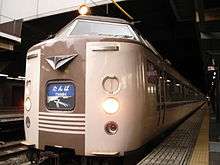Tamba (train)
The Tamba (たんば) was a limited express train service operated by West Japan Railway Company (JR West) in Japan. It operated between Kyoto and Fukuchiyama via the San'in Main Line, and was one of the services that make up JR West's "Big X Network". The color associated with the service was blue.
 183 series train on a Tamba service at Kyoto Station, March 2006 | |
| Overview | |
|---|---|
| Service type | Limited express |
| First service | 1960 |
| Last service | 2011 |
| Current operator(s) | JR West |
| Route | |
| Line(s) used | San'in Main Line |
| Technical | |
| Rolling stock | 183 series |
| Operating speed | 120 km/h (75 mph) |
Station stops
Kyoto – Nijō – Kameoka – Sonobe – (Hiyoshi) – (Goma) – (Wachi) – Ayabe – Fukuchiyama
Stations in parentheses were not served by all trains.[1]
Rolling stock
This service was operated with 4-car 183 series electric multiple unit trains based at Fukuchiyama Depot. Some trains operated coupled with 3-car Maizuru sets between Kyoto and Ayabe.[2] Some services had an entire Green (first class) car as car 1, while some services had only half of car 1 providing Green car accommodation.[1]
History
The Tamba (丹波) service was first introduced on 1 June 1960 as a "semi express" service operating between Osaka and Kinosaki (now Kinosaki Onsen).[3] It was upgraded to become an "express" service from 5 March 1966.[3] It was however discontinued from 1 November 1986.[4] The name Tamba comes from the feudal-era Tanba Province, which was situated in what is now northern Kyoto Prefecture and northeastern Hyōgo Prefecture.
From 16 March 1996, the Tamba name was revived for new limited express services operating between Kyoto and Fukuchiyama following the electrification of the Sanin Main Line.[3] From 18 March 2007, all cars were made non-smoking.[5] From the start of the 12 March 2011 timetable revision, Tamba services were absorbed into Kinosaki services.[6]
References
- JR Timetable, December 2010 issue, p.124-125
- JR新幹線&特急列車ファイル [JR Shinkansen & Limited Express Train File]. Japan: Kōtsū Shimbun. 2008. p. 42. ISBN 978-4-330-00608-6.
- Teramoto, Mitsuteru (23 July 2001). 国鉄・JR列車名大辞典 [JNR & JR Train Name Encyclopedia]. Tokyo, Japan: Chuoshoin Publishing Co., Ltd. pp. 344–346. ISBN 4-88732-093-0.
- 列車名鑑1995 [Train Name Directory 1995]. Japan: Railway Journal. August 1995. p. 127.
- JR電車編成表 2010夏 [JR EMU Formations – Summer 2010]. Japan: JRR. May 2010. p. 183. ISBN 978-4-330-14310-1.
- "JR West March 2011 revised timetable details" (PDF) (in Japanese). West Japan Railway Company. 17 December 2010. Archived from the original (PDF) on 23 May 2011. Retrieved 20 December 2010.
External links
- JR West Tamba 183 series train information (in Japanese)
.svg.png)